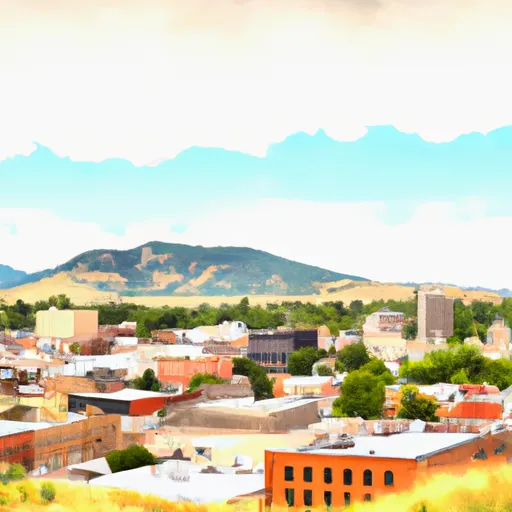-
 Snoflo Premium
Snoflo Premium
Get unlimited access to all our content
With no Ad interruptions! - Start Your Free Trial Login with existing account
Troy
Eden Index
Climate
7.7
•
Recreation
3.7
•
Community
•
Safeguard
4.4/10

Troy, Montana is a small town located in the northwest corner of the state, near the Idaho border. The climate in Troy can be categorized as a continental climate, with warm summers and cold winters. The average high temperature in the summer is around 80°F (27°C), while winter temperatures can drop below freezing, with an average low of 20°F (-7°C). The area experiences moderate precipitation throughout the year, with the majority falling as snow during the winter months.
Hydrologically, Troy is situated near the Kootenai River, which flows through the town. The river is known for its clean, clear waters and provides excellent fishing opportunities for trout and other species. Additionally, there are numerous lakes and streams in the surrounding area that offer recreational activities such as boating, swimming, and kayaking.
Troy is a haven for outdoor enthusiasts, with a plethora of recreational opportunities. The town is surrounded by vast forests, making it ideal for hiking, camping, and wildlife viewing. The nearby Kootenai National Forest offers miles of trails for hiking and mountain biking, as well as opportunities for hunting and birdwatching. Additionally, the area is known for its excellent hunting and fishing opportunities, attracting outdoor enthusiasts from all over.
In summary, Troy, Montana offers a continental climate with warm summers and cold winters. The town is located near the Kootenai River, providing excellent fishing opportunities, and is surrounded by beautiful forests, offering a range of outdoor activities such as hiking, camping, hunting, and wildlife viewing.
What is the Eden Index?
The Snoflo Eden Index serves as a comprehensive rating system for regions, evaluating their desirability through a holistic assessment of climate health, outdoor recreation opportunities, and natural disaster risk, acknowledging the profound impact of these factors on livability and well-being.
Climate Health Indicator (CHI): 7.7
Troy receives approximately
879mm of rain per year,
with humidity levels near 74%
and air temperatures averaging around
6°C.
Troy has a plant hardyness factor of
5, meaning
plants and agriculture in this region thrive during a short period during spring and early summer. Most
plants will die off during the colder winter months.
By considering the ideal temperature range, reliable water supplies, clean air, and stable seasonal rain or snowpacks, the Climate Health Indicator (CHI) underscores the significance of a healthy climate as the foundation for quality living.
A healthy climate is paramount for ensuring a high quality of life and livability in a region, fostering both physical well-being and environmental harmony. This can be characterized by ideal temperatures, reliable access to water supplies, clean air, and consistent seasonal rain or snowpacks.
Weather Forecast
Streamflow Conditions
Kootenai
Area Rivers
Kootenai
Snowpack Depths
Kootenai
Reservoir Storage Capacity
Kootenai
Groundwater Levels
Recreational Opportunity Index (ROI): 3.7
The Recreational Opportunity Index (ROI) recognizes the value of outdoor recreational options, such as parks, hiking trails, camping sites, and fishing spots, while acknowledging that climate plays a pivotal role in ensuring the comfort and consistency of these experiences.
Access to outdoor recreational opportunities, encompassing activities such as parks, hiking, camping, and fishing, is crucial for overall well-being, and the climate plays a pivotal role in enabling and enhancing these experiences, ensuring that individuals can engage in nature-based activities comfortably and consistently.
Camping Areas
| Campground | Campsites | Reservations | Toilets | Showers | Elevation |
|---|---|---|---|---|---|
| Yaak River | 44 | 1,849 ft | |||
| Yaak Falls | 7 | 2,424 ft | |||
| Kilbrennan Lake | 7 | 2,903 ft | |||
| Spar Lake | 14 | 3,327 ft | |||
| Pete Creek | 12 | 2,948 ft | |||
| Red Top | 5 | 2,902 ft | |||
| America Creek | 5 | 3,479 ft | |||
| Bad Medicine | 17 | 2,346 ft | |||
| Loon Lake | 4 | 3,655 ft | |||
| Dorr Skeels | 7 | 2,327 ft |
Nearby Fishing
Nearby Ski Areas
Catastrophe Safeguard Index (CSI):
The Catastrophe Safeguard Index (CSI) recognizes that natural disaster risk, encompassing floods, fires, hurricanes, and tornadoes, can drastically affect safety and the overall appeal of an area.
The level of natural disaster risk in a region significantly affects safety and the overall livability, with climate change amplifying these risks by potentially increasing the frequency and intensity of events like floods, fires, hurricanes, and tornadoes, thereby posing substantial challenges to community resilience and well-being.
Community Resilience Indicator (CRI):
The Community Resilience Indicator (CRI) recognizes that education, healthcare, and socioeconomics are crucial to the well-being of a region. The CRI acknowledges the profound impact of these elements on residents' overall quality of life. By evaluating educational resources, healthcare accessibility, and economic inclusivity, the index captures the essential aspects that contribute to a thriving community, fostering resident satisfaction, equity, and social cohesion.

